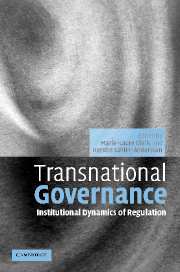Book contents
- Frontmatter
- Contents
- List of figures
- List of tables
- List of contributors
- Acknowledgments
- List of acronyms
- 1 Introduction: A world of governance: The rise of transnational regulation
- I Institutional forces
- II A dynamic transnational topography
- III Transnational governance in the making
- 12 Dynamics of soft regulations
- 13 Contested rules and shifting boundaries: International standard-setting in accounting
- 14 The international competition network: Moving towards transnational governance
- 15 The emergence of a European regulatory field of management education
- 16 Market creation and transnational rule-making: The case of CO2 emissions trading
- 17 Transnational NGO certification programs as new regulatory forms: Lessons from the forestry sector
- 18 Institutional dynamics in a re-ordering world
- References
- Index
13 - Contested rules and shifting boundaries: International standard-setting in accounting
Published online by Cambridge University Press: 22 September 2009
- Frontmatter
- Contents
- List of figures
- List of tables
- List of contributors
- Acknowledgments
- List of acronyms
- 1 Introduction: A world of governance: The rise of transnational regulation
- I Institutional forces
- II A dynamic transnational topography
- III Transnational governance in the making
- 12 Dynamics of soft regulations
- 13 Contested rules and shifting boundaries: International standard-setting in accounting
- 14 The international competition network: Moving towards transnational governance
- 15 The emergence of a European regulatory field of management education
- 16 Market creation and transnational rule-making: The case of CO2 emissions trading
- 17 Transnational NGO certification programs as new regulatory forms: Lessons from the forestry sector
- 18 Institutional dynamics in a re-ordering world
- References
- Index
Summary
Introduction
In this chapter we set out to investigate the emergence and development of international standard-setting in the field of accounting, with particular reference to financial reporting. Beyond technicalities and dry figures, financial reporting standards shape the categories through which corporate governance actors evaluate each other; thereby also influencing strategies and decision-making (Power 1997).
Historically, the meaning and understanding of accounting standards has been contextualized in national accounting traditions and systems. However, the last decades have seen a proliferation of activities and initiatives to make financial reporting standards comparable across national borders. Developments in accounting are part of a broader movement towards global ordering by means of standardization (Ahrne and Brunsson ch. 4; Drori and Meyer ch. 2). One common characteristic of international standardization is the lack of sanctioning power (cf Jacobsson and Sahlin-Andersson ch. 12). Thus, standard-setting organizations have to struggle for voluntary recognition of their rules. A second common feature is the degree of translation (Czarniawska and Joerges 1996) involved in international standardsetting. Actors that engage in international standard-setting contribute their contextualized interests, perceptions and strategies. The outcome of the standard-setting process is a set of highly formalized rules that need re-contextualization to be implemented. In consequence, struggles around international standards are expected to be quite significant (Brunsson and Jacobsson 2000; Tamm Hallström 2004).
- Type
- Chapter
- Information
- Transnational GovernanceInstitutional Dynamics of Regulation, pp. 266 - 286Publisher: Cambridge University PressPrint publication year: 2006
- 49
- Cited by



